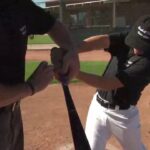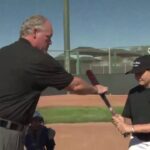NCAA 7-4 A Strike
A Strike
SECTION 4. A strike is:
a. A legal pitch struck at by the batter without the ball touching the bat;
b. A legal pitch that enters the strike zone (see definition and diagram in Rule 2) in flight and is not struck at; Note 1: The plate umpire should determine if the pitch is a strike in relationship to the batter’s normal position as the pitch crosses home plate. Any part of the ball passing over any part of the plate, from the bottom of the kneecaps to the midpoint between the top of the shoulders and the top of the uniform pants, is a strike. The pitch should be judged to be a strike or a ball as it crosses home plate, not where it is caught by the catcher. Note 2: If a pitched ball strikes the ground in front of the batter and the batter swings at it, the ball is in play if hit and a strike if missed.
c. A legal pitch that becomes a foul not caught on the fly when the batter has fewer than two strikes;
d. An attempt to bunt that results in a foul not legally caught;
e. A legal pitch that is in the strike zone and that touches the batter, regardless of whether he swings or not (the ball is immediately dead, the pitch is a strike, no runners may advance, and the batter is not awarded first base);
f. A foul tip;
g. Awarded after the batter fails to take a position in the batter’s box immediately after ordered by the umpire (see 7-1-c and 7-1-e); and
h. Awarded if the batter deliberately steps back in the box or swings in such a manner to attempt to create catcher’s interference. If the swing hits the catcher or the mitt, the batter shall be called out. All base runners shall return to the base occupied at the time of the pitch.
i. Awarded if the batter is judged to intentionally make a movement to be hit by a pitch, regardless of where the pitch is located; or allows himself to be intentionally hit by a pitch that is not thrown within the boundaries of the batter’s box unless it was not possible to avoid being hit.







